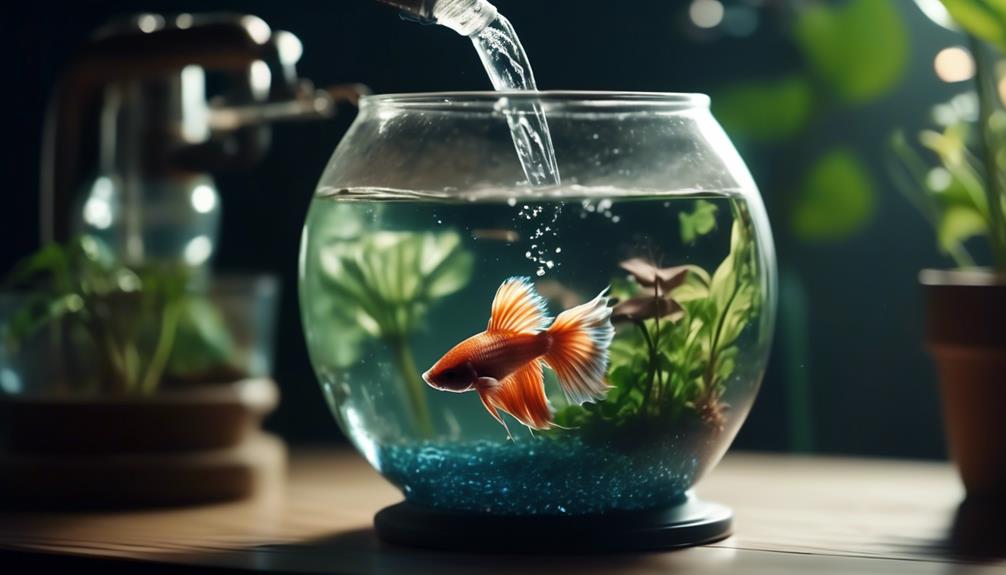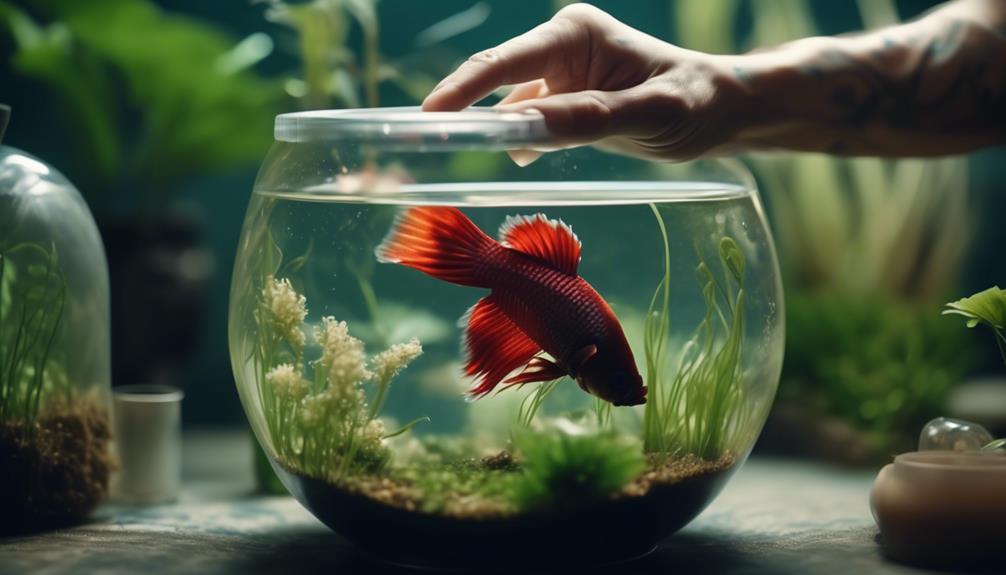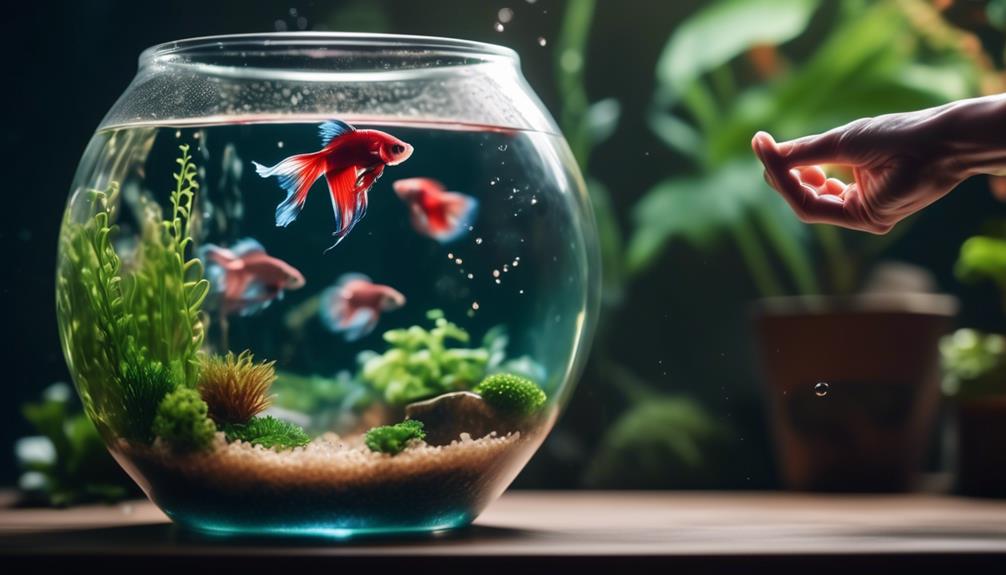Betta fish are one of the few fish that can live in a bowl. They don’t need a big tank to live happily.
They are not hard to take care of and they are tough little creatures.
In this quick, I’ll teach you to quickly clean a Betta fish bowl in less than 5 minutes. This easy way to clean your bowl might make you consider getting a Betta fish.
They are perfect for kids to learn how to care for pets because they are easier than bigger pets like cats or dogs.
Mike’s Thoughts
Here is a quick tl;dr for a 5-minute fish bowl clean up:

2. Begin the cleaning process by preparing dechlorinated water that matches the temperature of the water in the betta fish bowl to minimize stress on your fish.
3. Gently remove your betta fish from the bowl using a net and place it in a temporary container filled with some of the old tank water during the cleaning process.
4. Dispose of approximately 25-25% of the water from the bowl and remove any uneaten food or debris to prevent ammonia buildup.
5. Clean the bowl’s interior with a soft sponge or cloth, avoiding soap and chemicals that can be harmful to betta fish; instead, use hot water or a vinegar solution for stubborn algae.
6. Rinse any gravel or decorations with dechlorinated water to remove waste and debris without disrupting the beneficial bacteria.
7. After cleaning, slowly add the new, conditioned water to the bowl, ensuring it is free of chlorine and heavy metals which can be toxic to your betta.
8. Acclimate your betta to the new water conditions by gradually introducing small amounts of new water into its temporary container before transferring it back to the clean bowl.
9. Monitor water parameters like pH, ammonia, nitrite, and nitrate levels after cleaning to ensure a healthy environment for your betta fish.
10. Consider using a water conditioner and beneficial bacteria supplement to maintain a stable ecosystem in your betta’s bowl, promoting its health and longevity.
I’ve put a bunch more details below that expands on the topic, so feel free to read on and leave a comment or reach me on Facebook.
Step 1: Gathering Cleaning Supplies
If you got a filter in your fish bowl, it’s possible cycle the water while your betta is on it, but it’s tricky ’cause bowls are small and not the best home for fish.
You should clean the bowl every week, but never just once a month, okay?
If your bowl is big, the betta fish can stay in there when you clean it. Just swap out half the water. This keeps the betta calm.
Small tanks don’t have many filter choices and need cleaning more often than big tanks.
This is a complete guide that will help you to clean a betta fish bowl with rocks and it’s also suitable for beginners.
Before diving into the cleaning process, I’ll gather the following:
1. Soft cloth
2. Gravel vacuum
3. Bucket (for dirty water)
4. Water conditioner
5. Algae scraper (if needed)
I’m careful not to use soap or chemical cleaners that could harm my betta fish; instead, I rely on a clean sponge or cloth specifically for aquarium use to scrub the inside of the bowl.
The gravel vacuum is essential for removing uneaten food and waste products from the substrate, which can pollute the water.
A bucket or clean container is ready beside me to hold the dirty water I’ll siphon out during water changes. It’s a temporary container just for today’s task.
Before I add fresh tap water back into the bowl, I’ll treat it with water conditioner. This step is crucial to remove harmful chlorine and chloramine, making the water safe for my betta.
Lastly, if there’s stubborn algae on the glass, an algae scraper is handy to keep the bowl’s walls crystal clear.
Step 2: Prepare Clean Water
When you clean your fish bowl, you will only take out 20% to 25% of the water. Before you put in new water, get it ready 30 minutes before to let the water treatment work.
You should use a dechlorinator in the new tap water. This gets rid of chlorine and bad stuff for fish. Follow the directions to mix it right for the new water you’re adding. It needs about 30 minutes to work well.
No products found.
You can put aquarium salt for your betta fish or goldfish, but it’s not good for them always. In the wild, their home doesn’t have this salt. Only use it if you have distilled water in your fish bowl.
No products found.
Step 3: Safely Removing Your Betta
To ensure my betta’s safety, I’ll gently scoop it out with a clean, fish-safe net before cleaning the bowl. I’ve to be extra careful to reduce stress on my little buddy during this process. Here’s exactly how I do it:
- Use a small, soft net to carefully remove the betta from the tank.
No products found.
- Don’t rush; swift movements can frighten them.
- Transfer to a small container with some of the existing water.
- This helps maintain the water temperature and keeps conditions familiar.
Step 4: Cleaning Bowl and Decorations
Once my betta is safely in its temporary home, I make sure it’s comfortable while I clean the betta fish bowl. To keep the bowl clean and safe:
- Never use soap; it’s toxic for bettas. I rinse the bowl with warm water.
- Scrub away algae or residue with a clean, soft sponge.
- Use a small portion of the existing water to refill the bowl.
- This helps preserve the beneficial bacteria and minimizes shock.
When cleaning my betta fish bowl and decorations, I start by using a soft sponge or cloth to gently remove any dirt or algae without the use of soap or harsh chemicals.
No products found.
Soap residues can harm the delicate balance of the aquarium water and affect my betta’s health. I make sure to rinse the bowl and aquarium decorations thoroughly with warm, plain water.
You can also use vinegar if necessary.
This ensures that any loose particles are washed away without compromising the water quality.
Next, I take the artificial plants and other decorations out of the bowl to give them a deep clean.
Under running water, I carefully brush off any algae and dirt. It’s important not to use soap when cleaning these items either, as they can easily absorb harmful substances.
Once everything is sparkling clean, I dry off the decorations and set them aside.
Then, I proceed with the cleaning process by siphoning out about 20% of the aquarium water using a bucket or cup. This helps maintain a stable environment for my betta.
If the bowl’s outside is dirty, you can clean it using a simple sponge or cloth. It’s okay to use Windex, soap, or any other cleaning agents. Just make sure none of it gets inside the bowl.
You can also use cleaning magnets for algae but it’s a bit useless since you have already taken apart the tank.
No products found.
After I’ve finished cleaning, I replace the gravel, pebbles or rocks, and decorations, add the new, conditioned water, and slowly reintroduce my betta to its refreshed home, ensuring a clean and healthy habitat.
Step 5: Refreshing the Water

Having ensured the bowl and decorations are immaculate, it’s crucial to now focus on refreshing the water, which is an essential part of maintaining a healthy environment for a betta fish.
To keep my betta happy and healthy, I follow a simple water refresh routine:
Change 30-50% of the water in the bowl each week to remove toxins
Here’s how I go about adding new water:
- Prepare the new water (see step 2).
- Fill a clean container with tap water and add a water conditioner to neutralize harmful chemicals.
- Match the water temperatures.
- Float my betta in a bag with its old water in the cleaned bowl to acclimate it to the new water temperature.
After these steps, I carefully pour the water, ensuring the water level is appropriate and the fresh water blends seamlessly with the existing conditions. It’s a straightforward but vital task to keep my betta swimming merrily.
Step 6: Reintroducing Betta
After the water change, I carefully reintroduce my betta to the refreshed bowl, ensuring a gentle transition to minimize stress.
I make sure the clean betta fish bowl is at room temperature, matching the temporary container’s water to prevent temperature shock.
It’s crucial to verify that the new water is treated to remove chlorine and that the PH of the water is suitable for my tropical fish.
I then slowly pour my betta back into the bowl, allowing the remaining water from the container to mix with the new.
I avoid pouring any sediment or debris back into the tank, as this could contaminate the clean environment. I keep an eye on my betta for any signs of stress or discomfort after reintroducing your betta.
Changing only 30-50% of the water weekly is my usual practice to maintain stability. However, when a deep clean is necessary, usually once a month,
I ensure the tank is properly reassembled and the conditions are optimal before placing my betta back.
This gradual reintroduction helps my betta to readjust with ease, keeping him happy and healthy in his sparkling clean home.
Frequently Asked Questions
How Often Should I Clean My Betta Fish Bowl?
I should clean my betta fish bowl weekly to maintain water quality, control algae, ensure decoration safety, and reduce stress, considering bowl size, filtration options, and temperature stability to support the nitrogen cycle.
How Do You Clean a Fish Bowl Without Killing the Fish?
I carefully match water temperature and use a water conditioner during changes. Acclimation is key for fish health, so I ensure slow and gentle transitions while cleaning decorations, managing algae, and washing gravel.
What Is the Best Way to Clean a Betta Fish Bowl?
I start by scraping algae, then vacuum the gravel and disinfect the decor. I condition the water, maintain the filter, and control the temperature. I check the cycle and monitor ammonia and nitrate levels.
Can You Put Tap Water in a Betta Fish Bowl?
I can use tap water in my betta’s bowl, but I must treat it first. Water conditioning and chlorine neutralization are key. I ensure temperature matching and aeration for safe acclimation and chemical balance.
Conclusion
I’ve just finished giving my betta’s bowl a thorough clean, ensuring it’s a safe haven for my finned friend.
With fresh, dechlorinated water at the right temperature and pH, I gently placed my betta back into its sparkling home.
Regular cleaning is crucial, and with the right supplies and steps, it’s a breeze.
Remember, a clean bowl means a happy and healthy betta, and that’s what we’re all aiming for!

